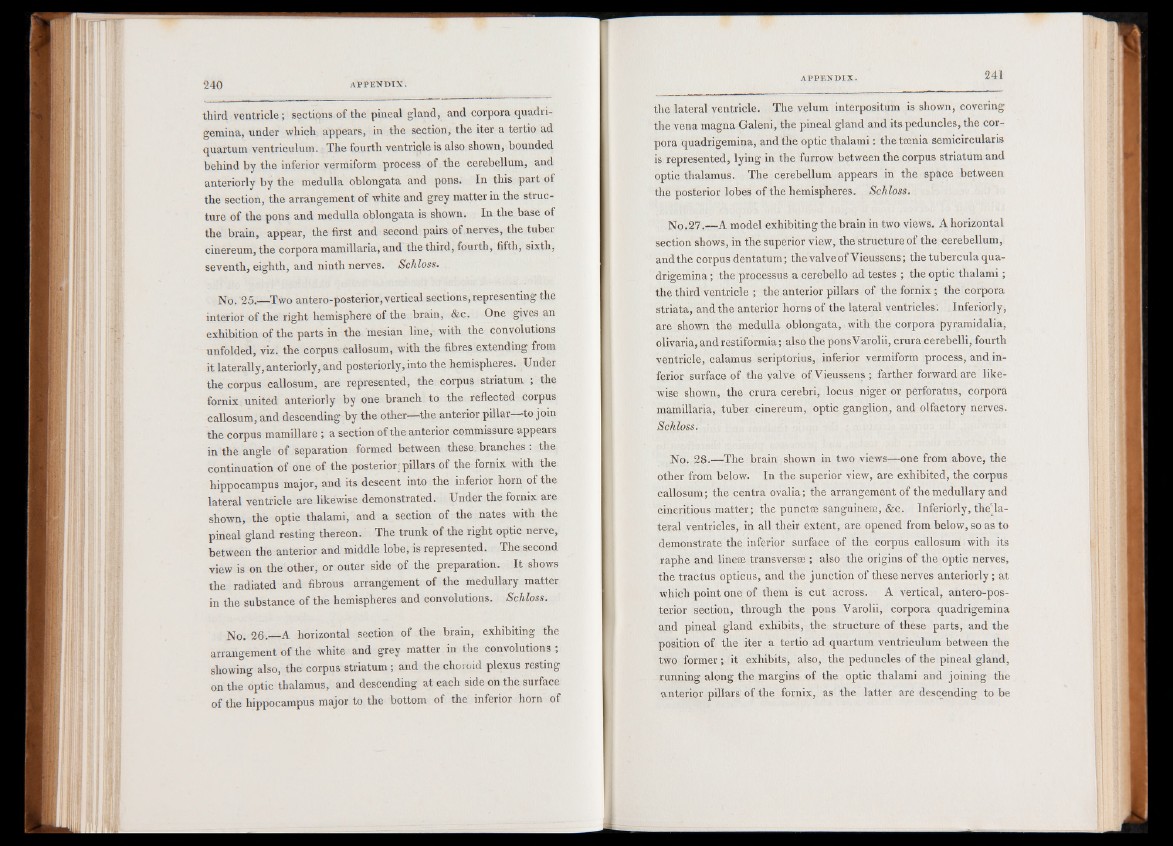
third ventricle; sections of the pineal gland, and corpora quadri-
gemina, under which appears, in the section, the iter a tertio ad
quartum ventriculum. The fourth ventricle is also shown, bounded
behind by the inferior vermiform process of the cerebellum, and
anteriorly by the medulla oblongata and pons. In this part of
the section, the arrangement of white and grey matter in the structure
of the pons and medulla oblongata is shown. In the base of
the brain, appear, the first and s e c o n d pairs of nerves, the tuber
cinereum, the corpora mamillaria, and the third, fourth, fifth, sixth,
seventh, eighth, and ninth nerves. Schloss.
No. 25.—Two antero-posterior, vertical sections,representing the
interior of the right hemisphere of the brain, &c. One gives an
exhibition of the parts in the mesian line, with the convolutions
unfolded, viz. the corpus callosum, with the fibres extending from
it laterally, anteriorly, and posteriorly, into the hemispheres. Under
the corpus callosum, are represented, the corpus striatum ; the
fornix united anteriorly by one branch to the reflected corpus
callosum, and descending by the other—the anterior pillar—to join
the corpus mamillare ; a section of the anterior commissure appears
in the angle of separation formed between these, branches : the
continuation of one of the posterior; pillars of the fornix with the
hippocampus major, and its descent into the inferior horn of the
lateral ventricle are likewise demonstrated. Under the fornix are
shown, the optic thalami, and a section of the nates with the
pineal gland resting thereon. The trunk of the right optic nerve,
between the anterior and middle lobe, is represented. The second
view is on the other, or outer side of the preparation. It shows
the radiated and fibrous arrangement of the medullary matter
in the substance of the hemispheres and convolutions. Schloss.
No. 26.—A horizontal section of the brain, exhibiting the
arrangement of the white and grey matter in the convolutions ;
showing also, the corpus striatum; and the choroid plexus resting
on the optic thalamus, and descending at each side on the surface
of the hippocampus major to the bottom of the inferior horn of
A PPEN D IX . 241
the lateral ventricle. The velum interpositum is shown, covering
the vena magna Galeni, the pineal gland and its peduncles, the corpora
quadrigemina, and the optic thalami: the taenia semicircularis
is represented, lying in the furrow between the corpus striatum and
optic thalamus. The cerebellum appears in the space between
the posterior lobes of the hemispheres. Schloss.
No.27.—A model exhibiting the brain in two views. A horizontal
section shows, in the superior view, the structure of the cerebellum,
and the corpus dentatum; the valve of Vieussens; the tubercula quadrigemina
; the processus a cerebello ad testes ; the optic thalami;
the third ventricle ; the anterior pillars of the fornix; the corpora
striata, and the anterior horns of the lateral ventricles: Inferiorly,
are shown the medulla oblongata, with the corpora pyramidalia,
olivaria, and restiformia; also the ponsVarolii, crura cerebelli, fourth
ventricle, calamus scriptorius, inferior vermiform process, and inferior
surface of the valve of Vieussens ; farther forward are likewise
shown, the crura cerebri, locus niger or perforatus, corpora
mamillaria, tuber cinereum, optic ganglion, and olfactory nerves.
Schloss.
N0< 28.—The brain shown in two views—one from above, the
other from below. In the superior view, are exhibited, the corpus
callosum; the centra ovalia; the arrangement of the medullary and
cineritious matter; the punctae sanguine®, &c. Inferiorly, theTa-
teral ventricles, in all their extent, are opened from below, so as to
demonstrate the inferior surface of the corpus callosum with its
raphe and lineae transversae ; also the origins of the optic nerves,
the tractus opticus, and the junction of these nerves anteriorly; at
which point one of them is cut across. A vertical, antero-posterior
section, through the pons Varolii, corpora quadrigemina
and pineal gland exhibits, the structure of these parts, and the
position of the iter a tertio ad quartum ventriculum between the
two former; it exhibits, also, the peduncles of the pineal gland,
running along the margins of the optic thalami and joining the
anterior pillars of the fornix, as the latter are descending to be